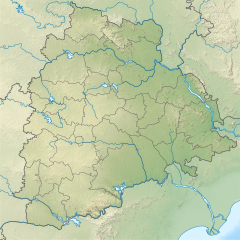
The Shakta pithas, Shakti pithas or Sati pithas are significant shrines and pilgrimage destinations in Shaktism, the mother goddess denomination in Hinduism. The shrines are dedicated to various forms of Adi Shakti. Various Puranas such as Srimad Devi Bhagavatam state the existence of a varying number of 51, 52, 64 and 108 Shakta pithas of which 18 are named as Astadasha Maha (major) in medieval Hindu texts.

Mahabubnagar district also known as Palamuru district is a district in the Indian state of Telangana. Mahabubnagar is the district headquarters which is popularly known as Palamoor. The district shares boundaries with Narayanapet, Vikarabad, Rangareddy, Nagarkurnool, Wanaparthy and Jogulamba Gadwal districts. The district was formed during the period of the 6th Nizam of Hyderabad State – Nawab Mir Mahbub Ali Khan and hence named after him.
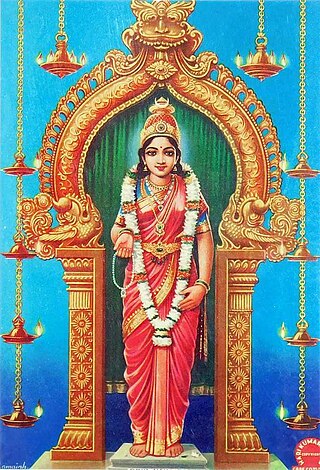
Devi Kanya Kumari is a manifestation of the Hindu goddess Mahadevi in the form of an adolescent girl. She is variously described by various traditions of Hinduism to either be a form of Parvati or Lakshmi. She is also worshipped as an incarnation of the goddess Bhadrakali by Shaktas, and is known by several names such as Shrī Bāla Bhadra, Shrī Bāla, Kanya Devi, and Devi Kumari.
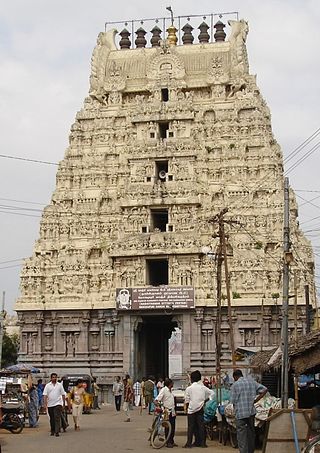
The Kamakshi Amman Temple, also known as Kamakoti Nayaki Kovil, is a Hindu temple dedicated to the goddess Kamakshi, one of the highest aspects of Adi Parashakti, the supreme goddess in Shaktism. The temple is located in the historic city of Kanchipuram, near Chennai, India.
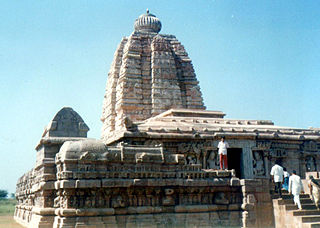
Alampuram (Hemalapuram) is a town situated in Jogulamba Gadwal district in the Indian state of Telangana. Alampur is a popular Hindu pilgrimage site in Shaktism and is also home to the Navabrahma Temples, a group of nine temples dedicated to Shiva built in the seventh and eighth century CE. It is the meeting point of the rivers Tungabhadra and Krishna and is referred to as Dakshina Kasi and is also considered the western gateway to Srisailam. The sacredness of Alampur is mentioned in the Skanda Purana. It is surrounded by the Nallamala hills and is situated on the left bank of the Tungabhadra River. Alampur was ruled by badami chalukyas they built 9 cluster of shiva temples. After them rashtrakutas of manyakheta and western chalukyas of karnataka built papanasi temples. Alampur is home to multiple Telugu and old Kannada inscriptions .Alampur contains numerous Hindu temples, the prominent ones being Jogulamba temple, Navabrahma temples, Papanasi temples, and Sangameswara Temple.

Jawalamukhi, or Jwalamukhi also Jawalaji, is a temple town and a nagar parishad in Kangra district in the Indian state of Himachal Pradesh. Hindu genealogy registers are kept here like that of Haridwar. The town takes its name from the holy Jwalamukhi Temple, located in Jawalamukhi. Firuz Shah Tughlaq during his campaign of Nagarkot destroyed the temple and desecrated its main deity. He stole 1300 Sanskrit Manuscripts from this temple's library that was later translated into Persian language, becoming the first Sultanate administration to do such translation.

Bhabanipur is a Hindu temple complex in northwestern Bangladesh located about 33 kilometres (21 mi) from Bogra. It is located in Sherpur Upazila of Bogra District, Rajshahi Division. It is one of the Shakti Pithas of the Indian subcontinent.

Sri Bhramaramba Mallikarjuna Temple or Srisailam Temple is a Hindu temple dedicated to the deities Shiva and Parvati, located at Srisailam in the Indian state of Andhra Pradesh. It is significant to the Hindu sects of both Shaivism and Shaktism as this temple is referred to as one of the twelve Jyotirlingas of Shiva and as one of the eighteen Shakti Pithas, centres of the Hindu Goddess. Shiva is worshiped as Mallikarjuna, and is represented by the lingam. His consort Parvati is depicted as Bhramaramba.

Chandika Sthan is a Hindu temple situated in Munger, in the India state of Bihar. It is one of the fifty-one Shakti Peethas, places of worship consecrated to the goddess Shakti. On the Northeast corner of Munger, Chandika Sthan is just two kilometers away from the Munger town. Being a Siddhi-Peetha, Chandika Sthan is considered to be one of the most sacred and sanctified temples, as important as the Kamakshya temple near Guwahati. Sati's left eye fell here and it is believed that those who worship here get rid of eye pain. It is one of the major Hindu pilgrimage centre in Ang Pradesh region of Bihar.
Sugandha Shaktipeeth, a temple of the Goddess Sunanda, is located in the village of Shikarpur, 10 miles north of Barisal, in Bangladesh. This Hindu temple is one of the Shakti Peethas.

Alampuram Navabrahma Temples are a group of nine early Badami Chalukyan Hindu temples dated between the 7th and 9th centuries that are located at Alampuram (Hemalapuram) in Telangana, India, near the meeting point of Tungabhadra River and Krishna River at the border of Andhra Pradesh. They are called Nava-Brahma temples though they are dedicated to Shiva. They exemplify early North Indian Nagara style architecture with cut rock as the building block. The temples of Alampur resemble the style of Pattadakal, Aihole style as they were Karnata Dravida, Vesara style native to Karnataka.

The temple of Attahas, is believed to be one of the 51 Shakti Peethas at which the body parts and jewelry of the Hindu goddess Shakti fell to Earth. The goddess is so large that the lower lip is about 15 to 18 feet wide. The temple is a site of Hindu pilgrimage throughout the year. December is a particularly popular time for visitors to picnic at the site.

Kottiyoor Vysakha Mahotsavam is an annual 27-day Hindu pilgrimage that commemorates the mythological Daksha Yaga. Similar to the Kumbh Mela of Prayag, this festival involves ritual ablutions. The vicinity is not called a temple because there are no permanent structures. Instead, a temporary hermitage built with Palmyra leaves is found and addressed as Yajna Bhoomi. Kottiyoor is revered as Dakshina Kasi.
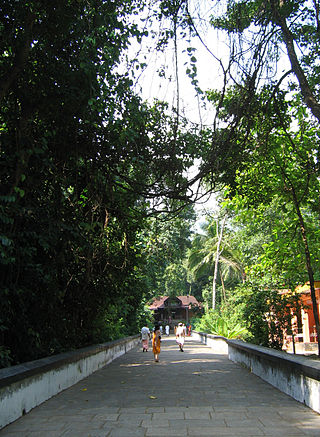
Kottiyoor Temple is a prominent Shiva temple in Kottiyoor, Kannur, Kerala, India. It was under the Kattan dynasty of Puralimala, from which the name 'Katti-yoor' originated. This name later evolved into Kottiyoor in the local dialect. Vadakkeshwaram Temple is the common name of the temple from ancient times, but some of the local people address the temple as Ikkare Kottiyoor as it is on the bank of the river close to the Kottiyoor village, to differentiate it from the shrine in the other side of the river. Thruchherumana Kshetram is also another name by which temple is known. The temple is a special category temple under Malabar Devaswom board.

Dakṣayajña is an important event in Hindu mythology that is narrated in various Hindu scriptures. It refers to a yajna (ritual-sacrifice) organised by Daksha, where his daughter, Sati, immolates herself. The wrath of the god Shiva, Sati's husband, thereafter destroys the sacrificial ceremony. The tale is also called Daksha-Yajna-Nasha. The legend forms the liturgical basis of the establishment of the Shakti Pithas, the temples of Mahadevi, the supreme deity of Shaktism. It also becomes a prelude to the legend of Parvati, Sati's reincarnation, who later marries Shiva.
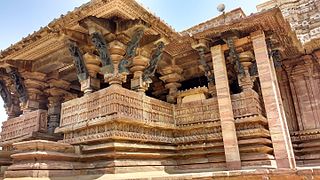
The earliest temples in Telangana include the Alampur Navabrahma Temples built during the 6th century CE by the Badami Chaulukyas.

The Culture of Telangana in India has a cultural history of about 5,000 years. The region emerged as the foremost centre of culture in Indian subcontinent during the rule of Kakatiyas, the Qutb Shahis and Asaf Jahi dynasties—. The rulers patronage and interest for culinary, arts and culture transformed Telangana into a multi-cultural region where two different cultures coexist together, thus making Telangana the representative of the Deccan Plateau and its heritage with Warangal and Hyderabad being its epicenter. Hyderabadi cuisine and Kakatiya architecture both from Telangana, are on the list of UNESCO creative city of gastronomy and UNESCO World Heritage Site. The regions major cultural events celebrated are "Kakatiya Festival" and Deccan Festival along with religious festivals Bonalu, Bathukamma, Dasara, Ugadi, Sankranthi, Milad un Nabi and Ramadan.
Arasuri Maa Ambe is a 2014 Indian short film that was shot in 3D and directed by Shiv Sagar, who is the grandson of Indian film director Ramanand Sagar. The movie was narrated by Amitabh Bachchan, starred Tej Sapru and Tarun Khanna, and chronicles the history of the Ambaji temple.
Three and a half Shakti Peethas are reported in Maharashtra.

Nandikeshwari Temple, also known as Nandikeshwari Tala, is located in Sainthia city of West Bengal. This temple is part of the famous Shakti Peethas in Indian Subcontinent.


